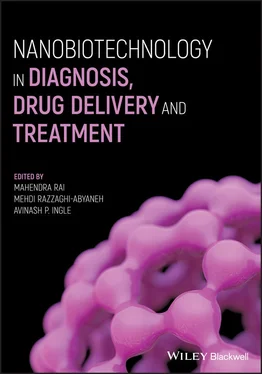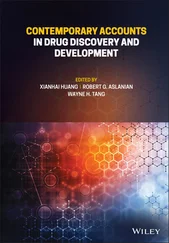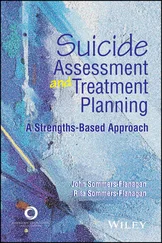1 Cover
2 Title Page Nanobiotechnology in Diagnosis, Drug Delivery, and Treatment Edited by Mahendra Rai Nanobiotechnology Laboratory Department of Biotechnology Sant Gadge Baba Amravati University Amravati, Maharashtra, India Mehdi Razzaghi‐Abyaneh Department of Mycology Pasteur Institute of Iran Tehran, Iran Avinash P. Ingle Department of Biotechnology Engineering School of Lorena University of Sao Paulo Lorena, Sao Paulo, Brazil
3 Copyright Page
4 List of Contributors
5 Preface
6 1 Nanotechnology: A New Era in the Revolution of Drug Delivery, Diagnosis, and Treatment of Diseases 1.1 Introduction 1.2 Nanomaterials Used in Diagnosis, Drug Delivery, and Treatment of Diseases 1.3 Role of Nanomaterials in Diagnosis, Drug Delivery, and Treatment 1.4 Advantages and Challenges Associated with Nanomaterials Used in Drug Delivery, Diagnosis, and Treatment of Diseases 1.5 Conclusion References
7 2 Selenium Nanocomposites in Diagnosis, Drug Delivery, and Treatment Nomenclature 2.1 Introduction 2.2 Nanoselenium: Application in Diagnosis 2.3 Nanoselenium and Antitumor Activity 2.4 Nanoselenium As a Part of Drug Delivery System 2.5 Nanoselenium for Alzheimer's Disease 2.6 Antibacterial Activity of Nanoselenium 2.7 Nanoselenium in Diabetes Treatment 2.8 Other Applications of Nanoselenium 2.9 Conclusion References
8 3 Emerging Applications of Nanomaterials in the Diagnosis and Treatment of Gastrointestinal Disorders 3.1 Introduction 3.2 Properties of Nanomaterials Affecting Their Potential Use in Medicine 3.3 Nanomaterials Used in Diagnosis and Treatment of Gastrointestinal Disorders 3.4 Nanoparticle Uptake in the Gastrointestinal Tract 3.5 Gastrointestinal Disorders and Their Treatment with Nanomaterials 3.6 Nanomaterials: Potential Treatment for Gastric Bacterial Infections 3.7 Nanostructures for Colon Cancer Diagnostics and Therapeutics 3.8 Conclusion and Future Perspectives References
9 4 Nanotheranostics: Novel Materials for Targeted Therapy and Diagnosis 4.1 Introduction 4.2 Magnetic Nanostructures 4.3 Gold/Silver‐Based Nanomaterials 4.4 Quantum Dot‐Based 4.5 Polymer‐Based Nanomaterials 4.6 Silica‐Based Nanomaterials 4.7 Carbon‐Based Nanomaterials 4.8 Conclusion and Future Perspectives References
10 5 Aptamer‐Incorporated Nanoparticle Systems for Drug Delivery 5.1 Introduction 5.2 Different Types of Aptamers for Drug Delivery 5.3 Aptamer‐Conjugated Nanosystems for Targeted Delivery Platforms 5.4 Aptamer‐Conjugated Nanosystems for Smart Delivery Platforms 5.5 Clinical Applications of Aptamers 5.6 Conclusion References
11 6 Application of Nanotechnology in Transdermal Drug Delivery 6.1 Introduction 6.2 What Is the Stratum Corneum (SC)? 6.3 Nanocarriers 6.4 Properties of Nanocarriers 6.5 Drug Delivery Systems 6.6 Potentials of Nanotechnology 6.7 Enhancement of TDD 6.8 Contribution of Nanotechnology in TDD in the Future 6.9 Conclusion References
12 7 Superparamagnetic Iron Oxide Nanoparticle‐Based Drug Delivery in Cancer Therapeutics 7.1 Introduction 7.2 Magnetic Drug Delivery Systems 7.3 Magnetic Delivery of Anticancer Drugs 7.4 Conclusion References
13 8 Virus‐Like Nanoparticle‐Mediated Delivery of Cancer Therapeutics 8.1 Introduction 8.2 Viruses as Bioinspired Delivery Vehicles 8.3 Virus‐Like Nanoparticle (VLNP) Production 8.4 VLNP‐Mediated Cancer Drug Delivery 8.5 Conclusions References
14 9 Magnetic Nanoparticles: An Emergent Platform for Future Cancer Theranostics 9.1 Introduction 9.2 Magnetic Properties of MNPs 9.3 Advantages of MNPs in Biomedicine 9.4 Preparation of MNPs 9.5 Coating of Magnetic Nanoparticles 9.6 Biomedical Applications of MNPs 9.7 Conclusions References
15 10 Chitosan Nanoparticles: A Novel Antimicrobial Agent 10.1 Introduction 10.2 Bioactivities of ChNPs 10.3 Factors Affecting the Antimicrobial Activity of ChNPs 10.4 Mode of Action of ChNPs 10.5 Conclusion References
16 11 Sulfur Nanoparticles: Biosynthesis, Antibacterial Applications, and Their Mechanism of Action 11.1 Introduction 11.2 Mechanisms of Antibiotic Resistance and Combination Therapy 11.3 Biosynthesis of Sulfur Nanoparticles (SNPs) 11.4 Antibacterial Application of SNPs 11.5 Possible Mechanisms for Antibacterial Action 11.6 Conclusion References
17 12 Role of Nanotechnology in the Management of Indoor Fungi 12.1 Introduction 12.2 Indoor Fungal Deterioration 12.3 Conventional Approach Used for the Control of Indoor Fungi 12.4 Nanotechnology for the Control of Fungal Growth 12.5 Hygienic Coatings and Nanotechnology 12.6 Conclusion References
18 13 Nanotechnology for Antifungal Therapy 13.1 Introduction 13.2 Basic Aspects of Nanotechnology in Medicine 13.3 Nanoparticulate Drug Delivery Systems for Refined Antifungal Therapy 13.4 Conclusions and Final Remarks References
19 14 Chitosan Conjugate of Biogenic Silver Nanoparticles: A Promising Drug Formulation with Antimicrobial and Anticancer Activities 14.1 Introduction 14.2 Conjugation of AgNPs with Natural Polymers 14.3 Conjugation of Bio‐AgNPs with Chitosan 14.4 Methods for Conjugation 14.5 Techniques Used for the Characterization of ChBio‐AgNPs 14.6 Bioactivities of ChBio‐AgNP Conjugate 14.7 Cytotoxicity Analysis 14.8 Conclusion Acknowledgment References
20 15 Leishmaniasis: Where Infection and Nanoparticles Meet 15.1 Introduction 15.2 Clinical Forms 15.3 Epidemiology 15.4 Life Cycle and Transmission 15.5 Diagnosis, Detection, and Surveillance 15.6 Treatment Strategies for Leishmaniasis 15.7 Nanotechnological Approach to Leishmaniasis Treatment 15.8 Conclusion References
21 16 Theranostics and Vaccines: Current Status and Future Expectations 16.1 Introduction 16.2 The Role of Theranostics and Vaccines in Early Diagnosis and Therapeutic Strategies in Different Diseases 16.3 Vaccine 16.4 Conclusions References
22 17 Toxicological Concerns of Nanomaterials Used in Biomedical Applications 17.1 Introduction 17.2 Factors Influencing the Toxicity of Nanoparticles 17.3 Why Is Toxicity Evaluation of Nanomaterials Necessary? 17.4 Toxicity of Nanomaterials Used in Biomedical Applications 17.5 Surface Engineering to Avoid Nanotoxicity 17.6 Conclusion and Future Perspectives Acknowledgments References
23 Index
24 End User License Agreement
1 Chapter 4 Table 4.1 Examples of commercially available Gd 3+chelate T 1‐Weighted MRI con... Table 4.2 Examples of commercially available IONP‐based T 2‐weighted MRI contr... Table 4.3 Typical combined applications of Au NRs.
2 Chapter 7Table 7.1 Superparamagnetic iron oxide nanoparticle‐based AMF‐induced in vitr...Table 7.2 Superparamagnetic iron oxide nanoparticle‐based AMF‐induced in vivo...
3 Chapter 8Table 8.1 Various plant virus nanoparticles and their potential applications ...
4 Chapter 9Table 9.1 Classification of iron oxide particles according to their size.
5 Chapter 10Table 10.1 Factors affecting antimicrobial activity of chitosan.
6 Chapter 11Table 11.1 Various biomaterials used for synthesis of SNPs.
7 Chapter 12Table 12.1 Details about antifungal efficacy of different nanoparticles again...
8 Chapter 13Table 13.1 Examples of commercially available antifungal nanoformulated drugs...
9 Chapter 14Table 14.1 Dose‐dependent RBC lysis assay of ChBio‐AgNPs.
10 Chapter 15Table 15.1 Clinical and epidemiological characteristics of the main Leishmania Table 15.2 Chemical structure and selected properties of existing antileishma...Table 15.3 A survey of reports on polymeric nanoparticles made from biodegrad...Table 15.4 Micellar drug delivery devices made from copolymers as appearing i...Table 15.5 Nanodrug delivery devices intended for treatment of leishmanial in...Table 15.6 Some selected reports on using bioconjugate drug delivery devices ...Table 15.7 Some selected reports on using inclusion compounds for treatment o...Table 15.8 Drug delivery devices developed for antileishmanial agents based o...Table 15.9 Selected liposomal drug delivery systems appearing in the literatu...Table 15.10 Other vesicular nanoparticles including niosomes, emulsomes, and ...Table 15.11 Nanodrug delivery vehicles based on solid lipid nanoparticles and...Table 15.12 Micro‐ and nanoemulsion products reported for treatment of leishm...Table 15.13 Nanodrug and nanosuspension products reported for treatment of le...Table 15.14 Inorganic nanoparticles used as antileishmanial agents per se or ...
Читать дальше










